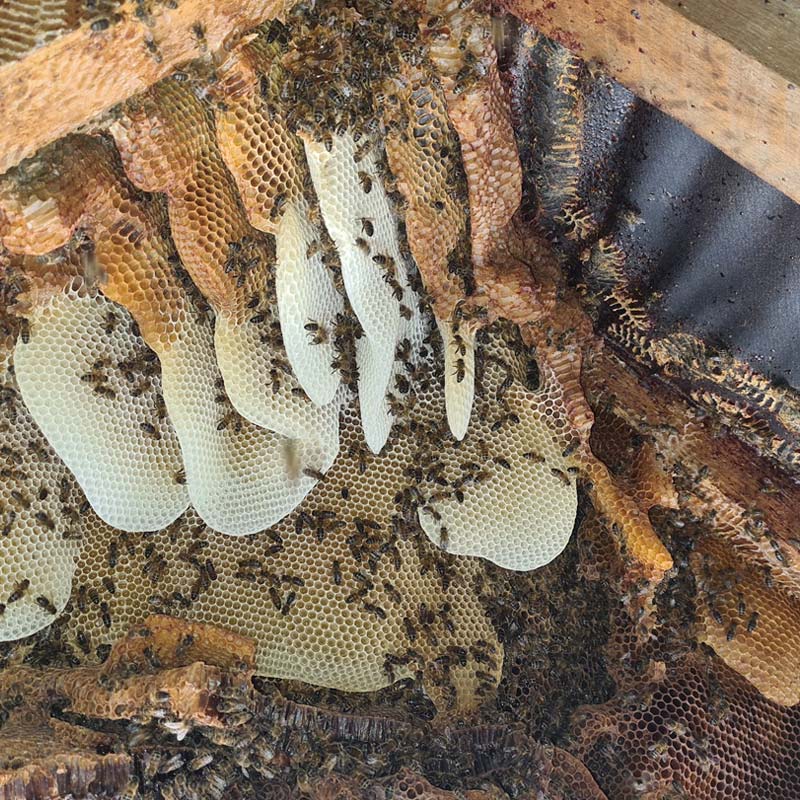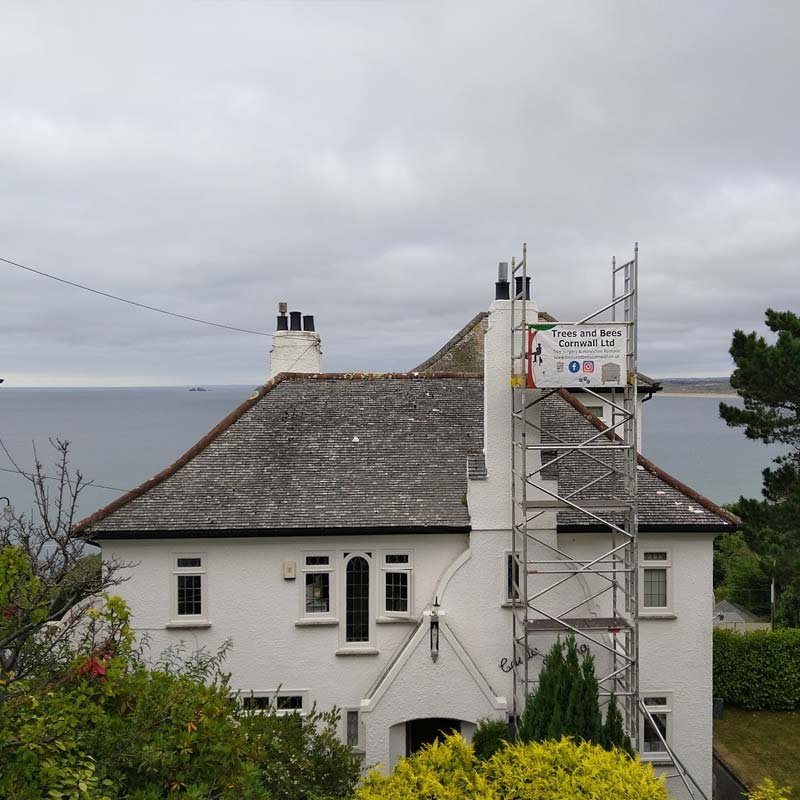Bees in buildings: The problems
Buildings, both old and new, contain lots of warm, dry spaces. In the wild, Honeybee colonies usually swarm in the spring and the swarm will go in search of a new home. Sometimes they can move into a natural home such as a cavity in an old tree but, very often, their scouts will find a more attractive home in a building. Older buildings tend to be more accessible to bees, but new buildings can be used as well. When mortar between bricks is worn, bees can find small holes which lead to a bigger area inside a chimney, roof space or wall cavity.




Once a colony has moved in, the area will be filled with wax honeycomb, honey and bees. Whilst honeybees do not ‘eat away’ at the fabric of a building, their presence can create a number of problems:
- Wax is flammable when heated and so presents a fire hazard, which could invalidate your home or buildings insurance, even if the nest is not in a chimney that you intend to use.
- If the nest happens to be between a chimney and a flue liner, then the risk of a chimney fire is very high.
- The bees’ flightpath may cross a footpath, driveway or lawn – which can increase the risk of bee stings. Bees don’t usually sting without good reason, but they can become defensive if they think that a person or animal presents a threat. Nests tend to be above head height, but this isn’t always the case. Even if you are comfortable with the bees being there, a neighbour or member of the public may not be.
- The weight of a nest can make roofing felt sag and tear over time, causing leaks.
- If the colony dies, they will usually leave behind a substantial amount of honey. This will inevitably leak at some point, sometimes through a ceiling. This can cause enormous damage and is best avoided.
N.B. DO NOT light a fire underneath an established bee colony in a chimney, in an attempt to remove bees. The wax honeycomb is likely to melt and fall into the fireplace (bringing with it several thousand bees) and can catch fire violently.
This video shows the typical size, layout and extent of a honeybee colony within a building. These are all from real-world colonies that we have removed:
BEE REMOVAL: WHAT WE DO
We will carry out an initial site survey from the ground using visual inspection, sometimes we will use a thermal camera, a drone, endoscope, or other tools to get the best idea of the bees’ exact location, along with the likely size of the colony. We can then discuss the options and costs for removal. In some circumstances, scaffolding will be required to enable the removal of the colony, but not for the initial inspection.
For the actual removal, we will remove bricks/tiles/cladding etc to access the nest. All honeycomb is removed sheet by sheet and any which is useful arranged into a hive. The bees will then move into the hive (sometimes with a little encouragement) where the comb, honey and eggs have been placed. Once the bees have been removed, any remaining wax, honey etc will be removed and the area cleaned. After this has been done, we will usually re-fit any bricks or tiles that have been removed and will endeavour, where possible, to make the area bee-proof (this is important to avoid future swarms from moving in).
For specialised building tasks (such as complex decorative brickwork) we will discuss how you wish to proceed e.g. if you have a preferred builder who you would wish to complete the work. Once removed, the bees will usually be moved to one of our apiaries for health checks, feeding (if required) and ongoing care.




Help – Bees are swarming at my house!
If you have noticed a cloud of honeybees above your house or garden, keep an eye on them. Close any upstairs windows if possible to avoid too many coming into the house. If the bees settle in a nearby tree or on the outside of the house, it is best to have them collected before they have the chance to move inside the structure of your home. We can collect swarms from ground level or at height. If the swarm is easily accessible (at or near ground level etc) a local beekeeper may be able to collect the swarm free of charge – you can find a local beekeeper to do so here (BBKA Swarm Collectors Page).
BUMBLEBEE REMOVAL
Bumblebees are usually much quieter and more docile than honey bees but situations can still arise where they create a problem.
Bumblebee nests are built by a single queen in the spring after she has hibernated and only last until the autumn and so, if they are in a spot where they can be tolerated for a few months then there is no need to move them, just wait until the nest is no longer active and then the access hole(s) can be blocked up to avoid repeat habitation. In the event that bumblebees are causing a risk to safety, often where either development or building maintenance is being undertaken, we are able to relocate them to one of our sites so that the nest can survive for the remainder of the season and the new queens that are produced towards the end of the season can go on to hibernate and create colonies of their own the following spring. Bumblebees are under more threat than honeybees and really do need our help so although we often try to avoid moving bumblebees unless necessary, we are always really pleased to relocate them when there is no other way!
RECENT ARTICLES ON BEE REMOVAL
Areas that we cover for Bee Removal:
We cover all of west Cornwall and the Lizard, along with parts of Mid-Cornwall, including:
St Just, Penzance, Marazion, St. Ives, Carbis Bay, Lelant, Hayle, Camborne, Redruth, Helston, Mullion, Constantine, Mawnan Smith, Falmouth, Penryn, Truro, St Agnes, Perranporth.
I have been very pleased with the bee removal and remedial work to the roof, from Ben and from Mark. They were cheerful and pleasant, they just got on with the work quietly and efficiently leaving no mess. They were a good choice for me to have made. Thanks Ben and Mark.
Peter – Sancreed, Cornwall



